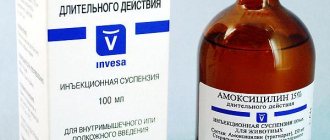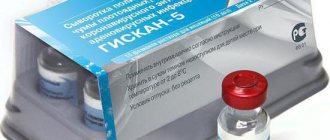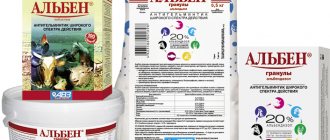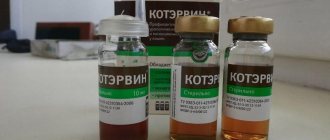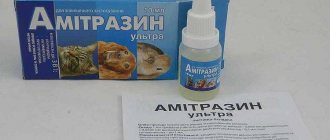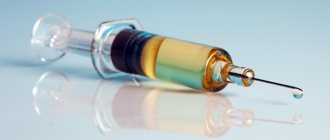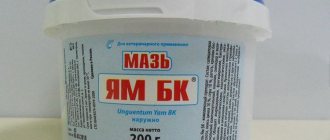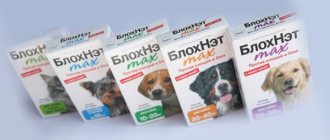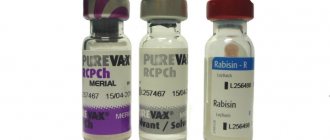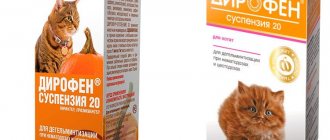Features of the veterinary product
What is Ditrim solution? The instructions for use state that this is a very effective antibacterial agent with a wide spectrum of action.
Thanks to its active components, this drug has a detrimental effect on the metabolism of acids contained in microbial cells.
This product is intended to treat and protect pets from various bacterial infections. It has fairly low toxicity and completely eliminates resistance in carriers of the disease.
Contraindications and side effects
The use of Ditrim is not recommended in the presence of hypersensitivity to individual components of the drug. The drug is not prescribed for the treatment of females during pregnancy and animals with kidney and liver diseases.
Be sure to read:
How and why do veterinarians use Fosprenil, for what viral diseases?
If medical recommendations are not followed while taking the medication, disruption of the digestive system may occur.
Properties of the veterinary drug
How does Ditrim solution work? The instructions state that trimethoprim and sulfadimezine, which are part of the drug, enhance each other’s effects. This occurs due to the sequential effects of folic and n-aminobenzoic acid on metabolism in microbial cells. This drug is active against gram-negative microorganisms and gram-positive bacteria.
When administered intramuscularly, this drug is resorbed and reaches peak concentration after 3 hours. Ditrim retains its antibacterial properties throughout the day. In lactating animals, the drug is excreted in milk, and in others - in urine.
Composition and release forms
The main active ingredients of Ditrim are sulfadimezin and trimethoprim.
In addition, the composition includes additional components: pyrrolidone; alcohol; EDTA; Na thiosulfate; water. Active ingredients for each ml of ditrim: 200 mg of sulfadimezine (or 20%) and 40 mg of trimethoprim (or 4%).
The drug is available in the form of a sterile, pale yellow solution . Packaged in sealed bottles from 20 to 500 ml. All bottles must be marked “Sterile” and “For Animals”, as well as the method of administration.
Spectrum of action
Ditrim is a broad-spectrum antibiotic. Sulfadimezine and trimethoprim increase the effectiveness of each other.
We also recommend reading:
Rabbits - as one of the most aggressive animals How rabbits compete in jumping and running Accessories for raising rabbits What breed of rabbits to choose for breeding at home
The mechanism of action is to disrupt the metabolism of folic and para-aminobenzoic acids inside the microorganism, which leads to its death. That is, the drug has bactericidal properties .
The activity of ditrim against both “gram+” and “gram−” microorganisms has been proven. Here is an incomplete list of microbes sensitive to the drug:
- Escherichia coli.
- Clostridia.
- Salmonella.
- Proteus.
- Staphylococci.
- Streptococci.
- Shigella.
- Corynebacteria.
- Klebsiella.
With low toxicity, ditrim is highly effective . And the above-mentioned bacteria have not yet developed resistance to it. However, this does not mean that the medicine can be used without supervision.
If antibiotics are constantly used, resistance of microorganisms will develop. This means that ditrim will become less effective not only in a particular animal, but also in the population as a whole.
Methods of drug administration and distribution in the body
The medicine is administered intramuscularly and reaches an effective concentration after about 3 hours.
The bactericidal properties last for 24 hours. Ditrim belongs to low-hazard drugs (class 4). Most of it is excreted in urine, and in lactating animals, in milk.
At the recommended dose, no negative effects were identified: locally irritating, teratogenic, embryotoxic and mutagenic. This means that the drug does not affect the development of the embryo. In addition, it is low-toxic for the animal itself .
Indications
For what diseases is Ditrim indicated for animals? The instructions state that this remedy is prescribed for the treatment of bacterial infections that are caused by microorganisms sensitive to it.
For different animals, the drug in question is used for different indications.
- Small cattle - for respiratory tract infections, diarrhea, metritis, pasteurellosis, salmonellosis, eimeriosis and others.
- Cattle – for bronchopneumonia, paratyphoid fever, colibacillosis, metritis, vibriosis diarrhea, etc.
- Horses – for bacterial pneumonia, septicopyemia, paratyphoid fever and diarrhea.
- Pigs - for respiratory tract infections, metritis, bacterial dysentery, pasteurellosis, paratyphoid fever, colibacillosis, MMA syndrome, eimeriosis, malignant edema, isosporosis and others.
- Dogs – for pulmonary and intestinal infections, cystoisosporosis.
- Rabbits – with eimeriosis and others.
- Chickens, turkeys and ducks - with eimeriosis, etc.
Indications for use
The drug is prescribed in the presence of infectious diseases caused by pathogens sensitive to the active components of the drug.
Be sure to read:
Treatment of birds and rabbits and other animals with Baytril: instructions and price
The medication is prescribed in the following cases:
- Cattle – metritis, bacterial intestinal diseases, pasteurellosis, bronchial pneumonia, colibacillosis.
- Small cattle - respiratory infections, digestive disorders, salmonellosis, coccidiosis.
- Dogs – in the treatment of infectious processes in the lungs and organs of the digestive system.
- Horses – bronchial pneumonia, paratyphoid fever, and diarrhea in foals.
- Pigs - for the treatment of infectious processes localized in the respiratory system, dysentery of bacterial origin, intestinal infections, swelling of malignant tissues.
- Rabbits - coccidiosis.
- Poultry – eimeriosis.
Important! Before using the medicine, consultation with a veterinarian is necessary.
Medicine for animals "Ditrim": instructions for use
For chickens and other poultry, this drug is prescribed (for prophylactic purposes) at a dosage of 1 ml/l of water for 3 days. For treatment, the drug in question is used in the same dose, but only for 5 days. The same goes for rabbits.
How else is the drug "Ditrim" used? The instructions state that this drug is prescribed to farm animals in the form of intramuscular injections (it is better for horses intravenously). Its dosage is calculated according to the following scheme: 1 ml per 10 kg of weight, once a day.
For acute infections, in the first three days the drug is administered in a loading dose of 1 ml per 10 kg of weight twice a day every 12 hours.
Treatment with the drug in question is continued for two days after all clinical signs of the disease have disappeared.
It is highly undesirable to continue therapy for more than 8 days. More than 20 ml of medication should not be injected into the same place.
Description and composition
Ditrim
The drug is available in the form of a sterile solution intended for injection, as well as in the form of a suspension for oral administration. The drug is packaged in hermetically sealed dark glass bottles of 10, 50 and 100 ml.
The main component of the drug is sulfadimezin, an antibacterial substance belonging to the group of sulfonamides.
It also contains trimethoprim , a bacteriostatic antibiotic belonging to the family of dihydrofolate reductase inhibitors. In addition, the drug contains other excipients.
All components complement and enhance each other’s action, thereby ensuring high effectiveness of the drug against most pathogenic bacteria.
Special Recommendations
The slaughter of animals for meat is permitted 29 days after the last use of the drug.
In case of forced slaughter of livestock (before the above-mentioned period), the meat should be given as feed to fur-bearing animals or for the production of bone meal.
Milk from lactating animals must not be used for food purposes for 6 days after the last administration of the medication. Such a product can only be used after heat treatment as animal feed.
Special instructions and storage
Slaughter of cattle for meat cannot be carried out earlier than a month from the date of the last injection. If it is necessary to slaughter before 28 days, the meat can be used to produce special meat and bone meal.
Milk can be used for food 5 days after completion of treatment. Before this period, milk can be used to feed animals only after heat treatment.
The drug belongs to list B. It must be stored at a temperature of 4–24 in a dry, dark place, inaccessible to children and animals. Under the specified storage conditions, ditrim is good for 2 years from the date of manufacture.
Analogues of the drug
Unfortunately, the veterinary pharmacy may not have the drug ditrim. In this case, you can use its analogues, for example, Ultradiazine and Triprim . But such a replacement must be previously agreed with a veterinarian, because the use and dosage of analogues may differ.
Ditrim, 100 ml
DESCRIPTION
Ditrim is a drug for the treatment of cattle, pigs, horses and dogs with diseases of bacterial etiology. In appearance, the drug is a transparent yellow liquid.
ADVANTAGES
- Wide spectrum of antimicrobial action
- Lack of habituation of microflora
- Administration of the drug intramuscularly 1 time per day
- Highly effective for use on all types of animals and poultry
- An effective remedy for the treatment of diseases caused by antibiotic-resistant strains of microorganisms
COMPOUND
1 ml of the drug contains sulfadimezine 200 mg, trimethoprim 40 mg, as well as auxiliary components.
PHARMACOLOGICAL PROPERTIES
Sulfadimezin and trimethoprim, which are part of Ditrim, enhance each other's action by sequentially affecting the metabolism of p-aminobenzoic and folic acids in the microbial cell, providing a wide spectrum of antibacterial action.
Ditrim is active against gram-positive and gram-negative microorganisms. When administered intramuscularly, Ditrim is resorbed and reaches maximum concentration 2-3 hours after injection. Therapeutic concentration is maintained for 24 hours. The drug is excreted from the body mainly through urine, and in lactating animals – partially through milk.
According to the degree of impact on the body, according to GOST 12.1.007-76 it is classified as a low-hazard substance (hazard class IV), in recommended doses it does not have a locally irritating, embryotoxic, teratogenic or mutagenic effect.
INDICATIONS
| Kind of animal | Diseases |
| Cattle | bronchopneumonia, colibacillosis, paratyphoid fever, metritis, vibriose diarrhea, coccidiosis |
| Small cattle | respiratory tract infections, metritis, diarrhea, pasteurellosis, salmonellosis, coccidiosis |
| Pigs | respiratory tract infections, metritis, bacterial dysentery, pasteurellosis, paratyphoid fever, colibacillosis, MMA syndrome, malignant edema, coccidiosis (eimeriosis, isosporosis) |
| Horses | bacterial pneumonia, septicopyemia, paratyphoid fever, foal diarrhea |
| Dogs | intestinal and pulmonary infections, cystoisosporosis |
| Rabbits | coccidiosis (eimeriosis) |
| Chickens, ducks, turkeys | coccidiosis |
APPLICATION
The drug is administered to farm animals in the form of intramuscular injections at a dose of 1 ml per 10 kg of live weight once a day. For acute infections, during the first 2-3 days the drug is administered in a loading dose (1 ml per 10 kg twice a day with an interval of 12 hours). Treatment is continued for 2 days after the disappearance of clinical signs of the disease. It is not recommended to continue treatment for more than 7-8 days. Inject no more than 20 ml of the drug into one injection site.
For rabbits and poultry, the drug is used in the form of freshly prepared drinking solutions.
Water with the drug serves as the only source of water for animals during the entire course of treatment.
CONTRAINDICATIONS
Contraindications for use are hypersensitivity to sulfonamide drugs, liver and kidney diseases. Not recommended for use during pregnancy.
It is not allowed to give the drug to laying hens.
During treatment with the drug, the use of n-aminobenzoic acid preparations (novocaine (procaine), anesthesin (benzocaine), bicillin) is prohibited. It is not recommended to mix it with other drugs in the same syringe (precipitate may form).
SIDE EVENTS
Slaughter for meat after the use of ditrim is permitted no earlier than: animals after 10 days; rabbits - 8 days, birds - 6 days after treatment.
Milk from animals treated with ditrim must not be used for food purposes for 3 days (6 milkings) after administration of the drug. It can be used to feed animals.
STORAGE
Store the medicinal product with caution, in the manufacturer's closed packaging, separately from food and feed, in a dry place, protected from direct sunlight, at a temperature from + 5°C to + 20°C.
PACKING
Ditrim is produced packaged in 100 ml glass bottles, hermetically sealed with rubber stoppers and rolled with aluminum caps.
Contraindications, side effects
If the recommended dosages are followed, no adverse symptoms are observed. Slight swelling and redness may be noticeable at the injection site. As a rule, such symptoms disappear on the 2-3rd day without therapy.
In rare cases, animals experience indigestion during or immediately after treatment. Allergic reactions, depression, drowsiness are possible. In case of overdose, hypersensitivity to the components of the drug disrupts the functioning of the kidneys and gastrointestinal tract (dysbacteriosis).
Ditrim is contraindicated in animals with individual intolerance to the components of the drug, hypersensitivity to sulfonamides, and chronic pathologies of the kidneys and liver. Not recommended for use by pregnant and lactating females.
It is permissible to slaughter animals for meat only 28–30 days after the end of the treatment course. Milk can be consumed 5 days after treatment. During forced slaughter, meat is used to make meat and bone meal.
DOSES OF DITRIM AND METHOD OF ADMINISTRATION TO DIFFERENT SPECIES OF ANIMALS
- Ditrim is prescribed to cattle, pigs, horses and dogs for the treatment of bacterial infections of the respiratory, gastrointestinal and genitourinary systems caused by microorganisms sensitive to the drug.
- The drug "Ditrim" is administered intramuscularly (intravenously to horses)
once a day at a dose of 1 ml per 10 kg of animal weight. In severe cases of the disease, for the first 2-3 days the drug is used twice a day with an interval of 12 hours in the same dose. - For dogs and piglets, Ditrim in a dose exceeding 5 ml, and for cattle, pigs, horses - 20 ml, is recommended to be administered intramuscularly with several injections at different points. The duration of the course of treatment is 3-7 days.
When used in recommended doses, side effects and complications are usually not observed. Some animals may experience redness and swelling at the injection site, which resolve spontaneously and do not require the use of medications.
In case of overdose or exceeding the duration of the recommended course of treatment, disturbances in the functioning of the kidneys and gastrointestinal tract (dysbacteriosis) are possible. In this case, it is necessary to stop using the drug and prescribe symptomatic treatment (alkaline liquids, vitamins and probiotics). The drug DITRIM should not be used simultaneously with n-aminobenzoic acid preparations (novocaine, procaine, anesthesin, benzocaine), and also, in order to avoid precipitation, mixed in the same syringe with other drugs.
